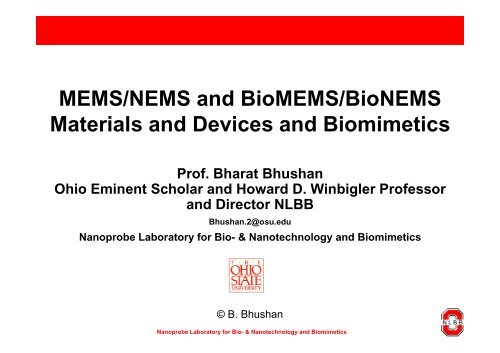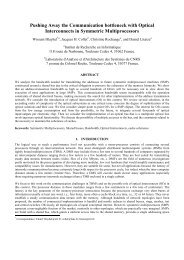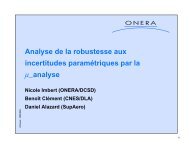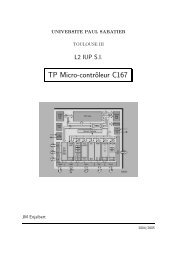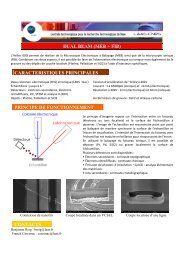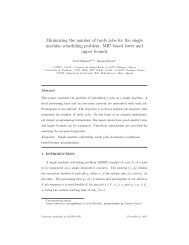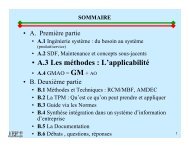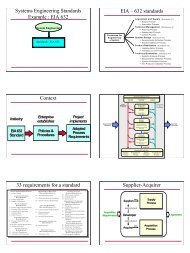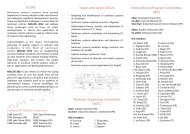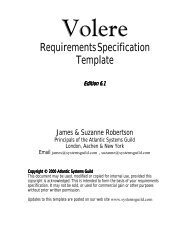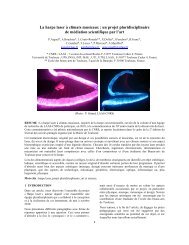Nanoprobe Laboratory for Bio- & Nanotechnology and Biomimetics
Nanoprobe Laboratory for Bio- & Nanotechnology and Biomimetics
Nanoprobe Laboratory for Bio- & Nanotechnology and Biomimetics
Create successful ePaper yourself
Turn your PDF publications into a flip-book with our unique Google optimized e-Paper software.
MEMS/NEMS <strong>and</strong> <strong>Bio</strong>MEMS/<strong>Bio</strong>NEMS<br />
Materials <strong>and</strong> Devices <strong>and</strong> <strong>Bio</strong>mimetics<br />
Prof. Bharat Bhushan<br />
Ohio Eminent Scholar <strong>and</strong> Howard D. Winbigler Professor<br />
<strong>and</strong> Director NLBB<br />
Bhushan.2@osu.edu<br />
<strong>Nanoprobe</strong> <strong>Laboratory</strong> <strong>for</strong> <strong>Bio</strong>- & <strong>Nanotechnology</strong> <strong>and</strong> <strong>Bio</strong>mimetics<br />
© B. Bhushan<br />
<strong>Nanoprobe</strong> <strong>Laboratory</strong> <strong>for</strong> <strong>Bio</strong>- & <strong>Nanotechnology</strong> <strong>and</strong> <strong>Bio</strong>mimetics
Outline<br />
• Background<br />
Definition of MEMS/NEMS <strong>and</strong> characteristic dimensions<br />
Examples of MEMS/NEMS <strong>and</strong> <strong>Bio</strong>MEMS/bioNEMS with nanotribology<br />
<strong>and</strong> nanomechanics issues<br />
<br />
<strong>Bio</strong>mimetics – Lessons from Nature<br />
• Experimental<br />
Atomic <strong>for</strong>ce/Friction <strong>for</strong>ce microscope (AFM/FFM)<br />
• Tribological Studies of Si <strong>and</strong> Related Materials<br />
Virgin, treated/coated silicon; polysilicon films <strong>and</strong> SiC film<br />
• <strong>Bio</strong>adhesion Studies<br />
Surface modification approaches to improve bioadhesion<br />
• Device Level Studies<br />
Nanotribological characterization of digital micromirror devices (DMD)<br />
• Hierarchical Nanostructures <strong>for</strong> Superhydrophobicity, self cleaning <strong>and</strong> low<br />
adhesion (Lotus Effect)<br />
<strong>Nanoprobe</strong> <strong>Laboratory</strong> <strong>for</strong> <strong>Bio</strong>- & <strong>Nanotechnology</strong> <strong>and</strong> <strong>Bio</strong>mimetics
Background<br />
Definition of MEMS/NEMS <strong>and</strong> characteristic dimensions<br />
MEMS - characteristic length less than 1 mm,<br />
larger than 100 nm<br />
NEMS - less than 100 nm<br />
Human hair<br />
50-100 μm<br />
500 nm<br />
DMD<br />
12 μm<br />
Quantum-dots transistor<br />
300 nm<br />
Red blood cell<br />
8 μm<br />
Molecular gear<br />
10 nm-100 nm<br />
SWNT chemical sensor<br />
2 nm<br />
C atom<br />
0.16 nm<br />
DNA<br />
2.5 nm<br />
0.1 1 10 100 1000 10000 100000<br />
Size (nm)<br />
Characteristic dimensions in perspective<br />
B. Bhushan, Springer H<strong>and</strong>book of <strong>Nanotechnology</strong>, Springer, 2 nd ed. (2007)<br />
<strong>Nanoprobe</strong> <strong>Laboratory</strong> <strong>for</strong> <strong>Bio</strong>- & <strong>Nanotechnology</strong> <strong>and</strong> <strong>Bio</strong>mimetics
Examples of MEMS/NEMS <strong>and</strong> <strong>Bio</strong>MEMS/NEMS<br />
shuttle<br />
springs<br />
gears <strong>and</strong> pin joint<br />
Microgear unit can be driven at speeds up<br />
to 250,000 RPM. Various sliding comp. are<br />
shown after wear test <strong>for</strong> 600k cycles at<br />
1.8% RH (Tanner et al., 2000)<br />
Microengine driven by electrostatically-actuated<br />
comb drive<br />
S<strong>and</strong>ia Summit Technologies (www.mems.s<strong>and</strong>ia.gov)<br />
<strong>Nanoprobe</strong> <strong>Laboratory</strong> <strong>for</strong> <strong>Bio</strong>- & <strong>Nanotechnology</strong> <strong>and</strong> <strong>Bio</strong>mimetics<br />
Stuck comb drive
Microfabricated commercial MEMS components<br />
5<br />
<strong>Nanoprobe</strong> <strong>Laboratory</strong> <strong>for</strong> <strong>Bio</strong>- & <strong>Nanotechnology</strong> <strong>and</strong> <strong>Bio</strong>mimetics
The generating points of friction <strong>and</strong> wear due to interaction of<br />
a biomolecular layer on a synthetic microdevice with tissue<br />
(Bhushan, Lee et al., 2006)<br />
<strong>Nanoprobe</strong> <strong>Laboratory</strong> <strong>for</strong> <strong>Bio</strong>- & <strong>Nanotechnology</strong> <strong>and</strong> <strong>Bio</strong>mimetics<br />
6
Need to address nanotribology <strong>and</strong> nanomechanics issues<br />
• The nanotribology <strong>and</strong> nanomechanics problems can drastically<br />
compromise device per<strong>for</strong>mance <strong>and</strong> reliability. To solve these<br />
problems, there is a need to develop a fundamental underst<strong>and</strong>ing<br />
of adhesion, friction/stiction, wear <strong>and</strong> the role of surface<br />
contamination <strong>and</strong> environment in MEMS/NEMS <strong>and</strong><br />
<strong>Bio</strong>MEMS/NEMS. This can be done by studying<br />
<br />
<br />
<br />
<br />
<br />
Approach<br />
Nanotribology <strong>and</strong> nanomechanics of MEMS/NEMS materials<br />
Lubricant methods <strong>for</strong> MEMS/NEMS<br />
<strong>Bio</strong>adhesion Studies<br />
Development of superhydrophobic surfaces<br />
Device level studies<br />
• Use an AFM/FFM <strong>for</strong> imaging <strong>and</strong> to study adhesion, friction, scratch <strong>and</strong><br />
wear properties of materials <strong>and</strong> lubricants, which better simulates<br />
MEMS/NEMS <strong>and</strong> <strong>Bio</strong>MEMS/<strong>Bio</strong>NEMS contacts<br />
• Develop <strong>and</strong> employ techniques to measure tribological phenomena in<br />
devices<br />
B. Bhushan et al., Nature 374, 607 (1995); B. Bhushan, H<strong>and</strong>book of Micro/Nanotribology, second ed., CRC Press, 1999;<br />
B. Bhushan, Introduction to Tribology, Wiley, NY, 2002; B. Bhushan, Springer H<strong>and</strong>book of <strong>Nanotechnology</strong>, 2 nd ed., 2007;<br />
B. Bhushan, Nanotribology <strong>and</strong> Nanomechanics – An Introduction, Springer, 2005.<br />
<strong>Nanoprobe</strong> <strong>Laboratory</strong> <strong>for</strong> <strong>Bio</strong>- & <strong>Nanotechnology</strong> <strong>and</strong> <strong>Bio</strong>mimetics
Lessons From Nature (<strong>Bio</strong>mimetics)<br />
<strong>Bio</strong>mimetics<br />
• <strong>Bio</strong>mimetics means mimicking biology or nature. It is derived from a<br />
Greek word “biomimesis.” Other words used include bionics, biomimicry<br />
<strong>and</strong> biognosis.<br />
• <strong>Bio</strong>mimetics involves taking ideas from nature <strong>and</strong> implementing them in<br />
an application.<br />
• Nature has gone through evolution over 3.8 billion years. It has evolved<br />
objects with high per<strong>for</strong>mance using commonly found materials.<br />
• <strong>Bio</strong>logical materials have hierarchical structure, made of commonly<br />
found materials.<br />
• It is estimated that the 100 largest biomimetic products had generated<br />
$1.5 billion over 2005-08. The annual sales are expected to continue to<br />
increase dramatically.<br />
M. Nosonovsky <strong>and</strong> B. Bhushan (2008), Multiscale Dissipative Mechanisms <strong>and</strong> Hierarchical Surfaces: Friction, Superhydrophobicity,<br />
<strong>and</strong> <strong>Bio</strong>mimetics, Springer-Verlag, Heidelberg, Germany; B. Bhushan (2007), Springer H<strong>and</strong>book of <strong>Nanotechnology</strong>, second ed.,<br />
Springer-Verlag, Heidelberg, Germany; B. Bhushan, Phil. Trans. R. Soc. A 367, 1445-1486 (2009).<br />
<strong>Nanoprobe</strong> <strong>Laboratory</strong> <strong>for</strong> <strong>Bio</strong>- & <strong>Nanotechnology</strong> <strong>and</strong> <strong>Bio</strong>mimetics<br />
8
Montage of some<br />
examples from nature.<br />
B. Bhushan, Phil. Trans. R. Soc. A 367, 1445-1486 (2009).).<br />
<strong>Nanoprobe</strong> <strong>Laboratory</strong> <strong>for</strong> <strong>Bio</strong>- & <strong>Nanotechnology</strong> <strong>and</strong> <strong>Bio</strong>mimetics<br />
9
Experimental<br />
Atomic <strong>for</strong>ce/Friction <strong>for</strong>ce microscope (AFM/FFM)<br />
• At most interfaces of technological relevance, contact occurs at<br />
numerous asperities. It is of importance to investigate a single<br />
asperity contact in the fundamental tribological studies.<br />
Engineering Interface<br />
Tip - based microscope allows<br />
simulation of a single asperity contact<br />
• Nanotribological studies are needed<br />
To develop fundamental underst<strong>and</strong>ing of interfacial phenomena<br />
on a small scale<br />
<br />
To study interfacial i phenomena in micro- or nanostructures t <strong>and</strong><br />
per<strong>for</strong>mance of ultra-thin films used in MEMS/NEMS<br />
components<br />
<strong>Nanoprobe</strong> <strong>Laboratory</strong> <strong>for</strong> <strong>Bio</strong>- & <strong>Nanotechnology</strong> <strong>and</strong> <strong>Bio</strong>mimetics
Tribological Studies of Si <strong>and</strong> Related Materials<br />
Macroscale friction <strong>and</strong> wear per<strong>for</strong>mance of silicon<br />
<strong>and</strong> effect of ion implantation<br />
Reciprocating sliding tests against an alumina ball at 1 N load.<br />
V refers to virgin silicon. S <strong>and</strong> P correspond to doped single-crystal<br />
<strong>and</strong> polycrystalline silicon. Ion energy used was 200 keV.<br />
B. K. Gupta, B. Bhushan et al., ASME J. Tribol. 115, 392 (1993); B. K. Gupta, B. Bhushan et al., Tribol. Trans. 37, 601 (1994)<br />
<strong>Nanoprobe</strong> <strong>Laboratory</strong> <strong>for</strong> <strong>Bio</strong>- & <strong>Nanotechnology</strong> <strong>and</strong> <strong>Bio</strong>mimetics
Scratch, wear <strong>and</strong> nanoindentation of virgin<br />
<strong>and</strong> treated/coated silicon<br />
Microscale scratch tests using a diamond tip in an AFM<br />
B. Bhushan <strong>and</strong> V. N. Koinkar, J. Appl. Phys. 75, 5741 (1994)<br />
<strong>Nanoprobe</strong> <strong>Laboratory</strong> <strong>for</strong> <strong>Bio</strong>- & <strong>Nanotechnology</strong> <strong>and</strong> <strong>Bio</strong>mimetics
Friction, scratch, wear <strong>and</strong> nanoindentation of<br />
polysilicon films <strong>and</strong> SiC film<br />
• Polysilicon films, undoped <strong>and</strong> doped are commonly used as<br />
MEMS materials<br />
• Silicon-based MEMS devices lack high-temperature capabilities<br />
with respect to both mechanical <strong>and</strong> electrical properties<br />
Density<br />
Hardness<br />
Elastic<br />
Fracture<br />
Thermal<br />
Coeff. of<br />
Melting B<strong>and</strong>-<br />
(kg/m 3 ) (GPa) modulus toughness conductivity thermal point gap<br />
(GPa) (MPa m 1/2 ) (W/m K) expansion ( ο C) (eV)<br />
(x 10 -6 / ο C)<br />
• SiC is being gpursued as a material <strong>for</strong> high-temperature<br />
microsensor <strong>and</strong> microactuator applications based on its<br />
successful use in high-power devices<br />
Sample<br />
β-SiC 3210 23.5-26.5 440 4.6 85-260 4.5 - 6 2830 2.3<br />
Si(100) 2330 9-10 130 0.95 155 2 – 4.5 1410 1.1<br />
Selected bulk properties of 3C SiC <strong>and</strong> Si(100)<br />
<strong>Nanoprobe</strong> <strong>Laboratory</strong> <strong>for</strong> <strong>Bio</strong>- & <strong>Nanotechnology</strong> <strong>and</strong> <strong>Bio</strong>mimetics
AFM 3D maps <strong>and</strong> average 2D profiles of<br />
scratch marks on various samples<br />
B. Bhushan, Tribology Issues <strong>and</strong> Opportunities in MEMS, Kluwer, 1998; S. Sundararajan <strong>and</strong> B. Bhushan, Wear 217, 251 (1998)<br />
<strong>Nanoprobe</strong> <strong>Laboratory</strong> <strong>for</strong> <strong>Bio</strong>- & <strong>Nanotechnology</strong> <strong>and</strong> <strong>Bio</strong>mimetics
Summary of tribological studies of MEMS/NEMS materials<br />
• Tribological properties of silicon are inadequate<br />
• Ion implantation ti <strong>and</strong> oxidation of silicon improve the<br />
tribological properties of silicon<br />
• SiC exhibits significantly better tribological properties than<br />
silicon-based materials <strong>and</strong> is a good c<strong>and</strong>idate <strong>for</strong><br />
MEMS/NEMS devices<br />
<strong>Nanoprobe</strong> <strong>Laboratory</strong> <strong>for</strong> <strong>Bio</strong>- & <strong>Nanotechnology</strong> <strong>and</strong> <strong>Bio</strong>mimetics
<strong>Bio</strong>adhesion Studies<br />
• Study surface modification approaches - nanopatterning <strong>and</strong><br />
chemical linker method to improve adhesion of biomolecules on<br />
silicon based surfaces.<br />
B. Bhushan et al., Acta <strong>Bio</strong>materialia 1, 327 (2005) ; ibid 2, 39 (2006); S. C. Lee et al., J. Vac. Sci. Technol. B 23, 1856 (2005) ;<br />
D. Tokachichu <strong>and</strong> B. Bhushan, IEEE Trans. Nanotech. 5, 228 (2006); E. Eteshola et al., J. Royal Soc. Interf. 5, 123 (2008); B.<br />
Bhushan et al., J. Royal Soc. Interf. 5(in press)<br />
<strong>Nanoprobe</strong> <strong>Laboratory</strong> <strong>for</strong> <strong>Bio</strong>- & <strong>Nanotechnology</strong> <strong>and</strong> <strong>Bio</strong>mimetics
Sample preparation<br />
STA: Streptavidin<br />
t APTES:Aminopropyltriethoxysilane<br />
NHS: N-hydroxysuccinimido<br />
BSA: Bovine serum albumin<br />
<strong>Nanoprobe</strong> <strong>Laboratory</strong> <strong>for</strong> <strong>Bio</strong>- & <strong>Nanotechnology</strong> <strong>and</strong> <strong>Bio</strong>mimetics
Schematic representation of deposition of streptavidin (STA) by chemical<br />
linker method<br />
<strong>Nanoprobe</strong> <strong>Laboratory</strong> <strong>for</strong> <strong>Bio</strong>- & <strong>Nanotechnology</strong> <strong>and</strong> <strong>Bio</strong>mimetics
Adhesion measurements in PBS with functionalized tips<br />
Patterned silica surface exhibits higher adhesion compared to<br />
unpatterned silica surface. <strong>Bio</strong>tin coated surface exhibits even higher<br />
adhesion.<br />
<strong>Nanoprobe</strong> <strong>Laboratory</strong> <strong>for</strong> <strong>Bio</strong>- & <strong>Nanotechnology</strong> <strong>and</strong> <strong>Bio</strong>mimetics
Device Level Studies<br />
Device level studies - digital micromirror devices (DMD)<br />
AFM images of the arrays which were<br />
removed by ultrasonic method<br />
<strong>Nanoprobe</strong> <strong>Laboratory</strong> <strong>for</strong> <strong>Bio</strong>- & <strong>Nanotechnology</strong> <strong>and</strong> <strong>Bio</strong>mimetics
Surface height<br />
ht<br />
The stuck mirror can be identified <strong>and</strong> removed by AFM.<br />
“Hard” stuck micromirror<br />
H. Liu <strong>and</strong> B. Bhushan, Ultramicroscopy 100, 391 (2004)<br />
<strong>Nanoprobe</strong> <strong>Laboratory</strong> <strong>for</strong> <strong>Bio</strong>- & <strong>Nanotechnology</strong> <strong>and</strong> <strong>Bio</strong>mimetics
The adhesive <strong>for</strong>ce of FP larger than no FP region on the l<strong>and</strong>ing site.<br />
Roughness <strong>and</strong> adhesion of l<strong>and</strong>ing sites<br />
<strong>Nanoprobe</strong> <strong>Laboratory</strong> <strong>for</strong> <strong>Bio</strong>- & <strong>Nanotechnology</strong> <strong>and</strong> <strong>Bio</strong>mimetics
Weak bonds exist<br />
close to the<br />
uncovered sites<br />
Wear could initiate if<br />
contact occurs at the<br />
defects sites<br />
PFDA delaminated<br />
from the interface<br />
Formation of high energy surface<br />
increases the water adsorption,<br />
which in turn leads to large adhesion<br />
Assembled<br />
molecules<br />
Defects<br />
in PFDA<br />
Uncovered<br />
sites<br />
Residual Molecular<br />
head groups<br />
fragments<br />
Water<br />
molecule<br />
Mechanisms <strong>for</strong> Wear <strong>and</strong> Stiction<br />
<strong>Nanoprobe</strong> <strong>Laboratory</strong> <strong>for</strong> <strong>Bio</strong>- & <strong>Nanotechnology</strong> <strong>and</strong> <strong>Bio</strong>mimetics
The “soft” stuck micromirror (S) contains the debris at the edges<br />
“Soft” Stuck Micromirror<br />
H. Liu <strong>and</strong> B. Bhushan, J. Vac. Sci. Technol. A 22, 1388 (2004)<br />
<strong>Nanoprobe</strong> <strong>Laboratory</strong> <strong>for</strong> <strong>Bio</strong>- & <strong>Nanotechnology</strong> <strong>and</strong> <strong>Bio</strong>mimetics
“Soft” stuck mechanisms<br />
<strong>Nanoprobe</strong> <strong>Laboratory</strong> <strong>for</strong> <strong>Bio</strong>- & <strong>Nanotechnology</strong> <strong>and</strong> <strong>Bio</strong>mimetics
H. Liu <strong>and</strong> B. Bhushan, <strong>Nanotechnology</strong> 15, 1246 (2004)<br />
<strong>Nanoprobe</strong> <strong>Laboratory</strong> <strong>for</strong> <strong>Bio</strong>- & <strong>Nanotechnology</strong> <strong>and</strong> <strong>Bio</strong>mimetics
Hiearchical Nanostructures <strong>for</strong> Superhydrophobicity,<br />
self-cleaning <strong>and</strong> low adhesion<br />
One of the crucial property p in wet<br />
environments is non-wetting or<br />
superhydrophobicity <strong>and</strong> self cleaning.<br />
These surfaces are of interest in various<br />
applications, e.g., self cleaning windows,<br />
windshields, exterior paints <strong>for</strong> buildings,<br />
navigation-ships <strong>and</strong> utensils, roof tiles,<br />
textiles <strong>and</strong> reduction of drag in fluid flow,<br />
e. g. in micro/nanochannels. Also,<br />
superhydrophobic surface can be used <strong>for</strong><br />
energy conservation <strong>and</strong> energy<br />
conversion such as in the development elopment of<br />
a microscale capillary engine.<br />
Reduction of wetting is also important in<br />
reducing meniscus <strong>for</strong>mation,<br />
consequently reducing stiction.<br />
SEM of Lotus leaf showing bump structure.<br />
Various natural surfaces, including various<br />
leaves, e. g. Lotus, are known to be<br />
superhydrophobic, due to high roughness<br />
<strong>and</strong> the presence of a wax coating<br />
(Neinhuis <strong>and</strong> Barthlott, 1997)<br />
NY Times, 1/27/05; ABCNEWS.com, 1/26/05; Z. Burton <strong>and</strong> B. Bhushan, Ultramicroscopy 106, 709 (2006); B. Bhushan <strong>and</strong> Y. C. Jung,<br />
<strong>Nanotechnology</strong> 17, 2758 (2006); B. Bhushan <strong>and</strong> Y. C. Jung, J. Phys.: Condens. Matter 20, 225010 (2008)<br />
<strong>Nanoprobe</strong> <strong>Laboratory</strong> <strong>for</strong> <strong>Bio</strong>- & <strong>Nanotechnology</strong> <strong>and</strong> <strong>Bio</strong>mimetics
Rolling off liquid droplet over superhydrophobic Lotus leaf<br />
with self cleaning ability<br />
<strong>Nanoprobe</strong> <strong>Laboratory</strong> <strong>for</strong> <strong>Bio</strong>- & <strong>Nanotechnology</strong> <strong>and</strong> <strong>Bio</strong>mimetics
Roughness optimization model <strong>for</strong> superhydrophobic <strong>and</strong> self<br />
cleaning surfaces<br />
Complete wetting<br />
Composite interface<br />
In fluid flow, another property of<br />
interest is contact angle<br />
hysteresis (θ H )<br />
α : Tilt angle<br />
Cassie-Baxter equation:<br />
cosθ<br />
= R f cosθ<br />
− f<br />
Droplet of liquid in contact with<br />
f<br />
SL 0 LA<br />
a smooth <strong>and</strong> rough surface<br />
Wenzel’s equation:<br />
cos<br />
θ<br />
= R<br />
cos<br />
θ<br />
R f o<br />
θ<br />
H<br />
= θ<br />
adv<br />
− θ<br />
rec<br />
R<br />
≈<br />
f<br />
1−<br />
f<br />
LA<br />
2( R<br />
(cosθθ<br />
f<br />
rec0<br />
cosθ<br />
<strong>for</strong> high contact angle<br />
(θ 180°)<br />
0<br />
− cosθθ<br />
f<br />
f<br />
= Rf<br />
cos θ0 − fLA( Rf<br />
cosθ0<br />
+ 1) Increase in f LA <strong>and</strong> reduction<br />
http://lotus-shower.isunet.edu/the_lotus_effect.htm<br />
+ 1)<br />
in R f decrease θ H<br />
M. Nosonovsky <strong>and</strong> B. Bhushan, Microsyst. Tech. 11, 535 (2005); ibid, 231 (2006); Microelectronic Eng. 84, 387 (2007); Ultramicroscopy 107, 969<br />
(2007); Nano Letters 7, 2633 (2007); J. Phys.: Condens. Matter 20, 225009 (2008); US Patent pending (2005); Y.C. Jung <strong>and</strong> B. Bhushan,<br />
<strong>Nanotechnology</strong> 17, 4970 (2006); B. Bhushan <strong>and</strong> Y.C. Jung, J. Phys.: Condens. Matter 20, 225010 (2008)<br />
<strong>Nanoprobe</strong> <strong>Laboratory</strong> <strong>for</strong> <strong>Bio</strong>- & <strong>Nanotechnology</strong> <strong>and</strong> <strong>Bio</strong>mimetics<br />
adv0<br />
)
Structure t of ideal hierarchical surface<br />
• Based on the modeling <strong>and</strong> observations made on leaf surfaces, hierarchical<br />
surface is needed d to develop composite interface with high h stability.<br />
• Proposed transition criteria can be used to calculate geometrical parameters <strong>for</strong><br />
a given droplet radius. For example, , <strong>for</strong> a droplet on the order of 1 mm or<br />
larger, a value of H on the order of 30 μm, D on the order of 15 μm <strong>and</strong> P on the<br />
order of 130 μm is optimum.<br />
• Nanoasperities should have a small pitch to h<strong>and</strong>le nanodroplets, less than 1<br />
mm down to few nm radius. The values of h on the order of 10 nm, d on the<br />
order of 100 nm can be easily fabricated.<br />
<strong>Nanoprobe</strong> <strong>Laboratory</strong> <strong>for</strong> <strong>Bio</strong>- & <strong>Nanotechnology</strong> <strong>and</strong> <strong>Bio</strong>mimetics
Fabrication <strong>and</strong> characterization of hierarchical surface<br />
Fabrication of microstructure<br />
• Microstructure<br />
Replication of Lotus leaf <strong>and</strong> micropatterned silicon surface using<br />
an epoxy resin <strong>and</strong> then cover with the wax material<br />
B. Bhushan et al., Soft Matter 4, 1799 (2008); Appl. Phys. Lett. 93, 093101 (2008); Ultramicroscopy (in press); Langmuir 25, 1659-1666 (2009);<br />
Koch et al., Soft Matter 5, 1386-1393 (2009) <strong>Nanoprobe</strong> <strong>Laboratory</strong> <strong>for</strong> <strong>Bio</strong>- & <strong>Nanotechnology</strong> <strong>and</strong> <strong>Bio</strong>mimetics
Fabrication of nanostructure <strong>and</strong> hierarchical structure<br />
Recrystallization of wax tubules<br />
• Nanostructure<br />
Self assembly of the Lotus wax deposited by thermal evaporation<br />
• Expose to a solvent in vapor phase <strong>for</strong> the mobility of wax molecules<br />
• Hierarchical structure<br />
Lotus <strong>and</strong> micropatterned epoxy replicas <strong>and</strong> covered with the tubules of Lotus wax<br />
B. Bhushan et al., Soft Matter 4, 1799 (2008); Appl. Phys. Lett. 93, 093101 (2008); Ultramicroscopy (in press); Langmuir 25, 1659-1666 (2009);<br />
Koch et al., Soft Matter 5, 1386-1393 (2009) <strong>Nanoprobe</strong> <strong>Laboratory</strong> <strong>for</strong> <strong>Bio</strong>- & <strong>Nanotechnology</strong> <strong>and</strong> <strong>Bio</strong>mimetics
Static contact angle, contact angle hysteresis, tilt angle <strong>and</strong> adhesive <strong>for</strong>ce on<br />
various structures<br />
• Nano- <strong>and</strong> hierarchical structures with tubular wax led to high static contact<br />
angle of 167º <strong>and</strong> 173º <strong>and</strong> low hysteresis angle on the order of 6º <strong>and</strong> 1º.<br />
• Compared to a Lotus leaf, hierarchical structure showed higher static<br />
contact angle <strong>and</strong> lower contact angle hysteresis.<br />
B. Bhushan, Y. C. Jung, A. Niemietz, <strong>and</strong> K. Koch, Langmuir (in press)<br />
<strong>Nanoprobe</strong> <strong>Laboratory</strong> <strong>for</strong> <strong>Bio</strong>- & <strong>Nanotechnology</strong> <strong>and</strong> <strong>Bio</strong>mimetics
Self-cleaning efficiency of various surfaces<br />
• As the impact pressure of the droplet is zero or low, most of particles on<br />
nanostructure were removed by water droplets, resulting from geometrical scale<br />
effects.<br />
• As the impact pressure of the droplet is high, h all particles which h are sitting at the<br />
bottom of the cavities between the pillars on hierarchical structure were removed by<br />
the water droplets.<br />
<strong>Nanoprobe</strong> <strong>Laboratory</strong> <strong>for</strong> <strong>Bio</strong>- & <strong>Nanotechnology</strong> <strong>and</strong> <strong>Bio</strong>mimetics
Summary of nanotribology of bioadhesion <strong>and</strong> device level studies as<br />
well as hierarchical surfaces<br />
• <strong>Bio</strong>adhesion studies<br />
Adhesion between silica surfaces <strong>and</strong> biomolecules using chemical linker<br />
method is stronger than by direct adsorption<br />
• Device level studies<br />
Wear of the SAMs lubricant at the defects region can lead to the increase of<br />
surface energy which causes the increase of adhesion <strong>and</strong> lead to “hard”<br />
stiction.<br />
Micromirror sidewall contamination particles could cause micromirror “soft”<br />
stiction.<br />
• Hierarchical surfaces<br />
Optimum roughness distribution can be used to generate superhydrophobic<br />
surfaces.<br />
<strong>Nanoprobe</strong> <strong>Laboratory</strong> <strong>for</strong> <strong>Bio</strong>- & <strong>Nanotechnology</strong> <strong>and</strong> <strong>Bio</strong>mimetics
Acknowledgements<br />
• Financial support has been provided by the National Science Foundation<br />
(Contract No. ECS-0301056 ), the <strong>Nanotechnology</strong> Initiative of the National<br />
Institute of St<strong>and</strong>ards <strong>and</strong> Technology in conjunction with Nanotribology<br />
Research Program (Contract No. 60 NANB1D0071), <strong>and</strong> Texas Instruments,<br />
Intel Corp <strong>and</strong> Nanochip Inc.<br />
• Polysilicon <strong>and</strong> SiC work was per<strong>for</strong>med in collaboration with Prof. M.<br />
Mehregany <strong>and</strong> Dr. C. A. Zorman at Case Western Reserve University<br />
• The <strong>Bio</strong>MEMS/<strong>Bio</strong>NEMS studies were carried out in collaboration with Prof.<br />
S. C. Lee of OSU Medical School <strong>and</strong> Prof. D. Hans<strong>for</strong>d of <strong>Bio</strong>medical Eng.<br />
• DMD chips were supplied by Dr. S. Joshua Jacobs of Texas Instruments<br />
<strong>Nanoprobe</strong> <strong>Laboratory</strong> <strong>for</strong> <strong>Bio</strong>- & <strong>Nanotechnology</strong> <strong>and</strong> <strong>Bio</strong>mimetics


